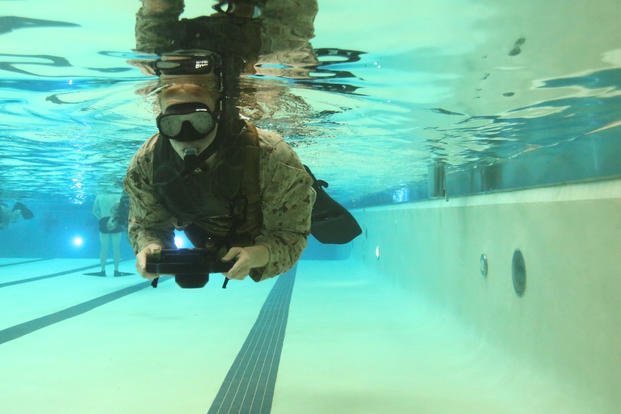Preparing for a future in military diving, special ops programs, and rescue swimming requires the mastery of several water skills, including treading, swimming fast without fins and swimming longer distances with fins. Add in underwater swimming, scuba diving, and navigating underwater at night and you’ll likely understand why so many special operation programs have high attrition rates when working in an aquatic environment.
Here is a question about the different levels of training needed between fast swimming without fins and longer-distance swimming with fins:
Stew, what are the training/cardio differences between preparing for the 500m swim test without fins and swimming longer distances with fins? Sebastien
Sebastien, great question. I do not think I have answered this question specifically before and addressed not only the similarities and differences, but also the necessary progression to prepare for military special operations training programs.
Typically, swimming without fins for testing is done in under 10 minutes, but some (like Air Force combat rescue officers, for example) have to swim 1,500 meters without fins, which can take 25-30 minutes. The cardio training will depend on the distance you get tested, as it is like testing a 1.5-mile timed run vs. a four-mile timed run. Swimming with fins is more like running 10-12 miles and takes 70+ minutes for most people swimming two miles (like the weekly test at SEAL training).
Here is a list of the differences and similarities to help you understand how to implement more of both into your training:
1. Upper-Body Day
If you are preparing for any special-ops program, you will likely be preparing your strength and muscle stamina for load bearing and high-rep calisthenics, such as pull-ups, push-ups and sit-ups for testing and other lifts like push presses and military presses for log-type PT. But you also need to be running and swimming, as most fitness tests for these groups will include all of the above.
We tend to work swimming without fins into upper-body days for extra cardio training. I advise getting good at the fitness-test swim distances (500 yards, 500 meters, 1,500 meters), depending on the branch of service, by using workouts like the 50-50 or 100-100. You may think you are in shape because you are a great runner, but swimming conditioning is different. You have to get into swimming shape, and these workouts are helpful if you do them 4-5 times a week.
2. Lower-Body Day
A strong and durable spine, hips and legs are essential for enduring load-bearing events like rucking, log PT, and carrying equipment and people. This requires leg muscle stamina and strength training with squats, lunges, deadlifts and rucking. But there is also a need for strong hips and legs to swim (and tread) with fins. The Rocket or Jet Fins you get issued are unforgiving and will hurt your feet and ankles. Building your swimming volume each week is essential to your success and ability to swim longer distances.
Swimming with fins will most likely be for up to 1-2 hours in the open water during training, so the cardio base training is different and more similar to a long, slow distance run type of aerobic base training. Legs, ankles and feet tend to give out before the heart and lungs do, so prepare the joints with mobility training on top of adding in 5-10 kilometers of swimming in fins each week (on leg days) or on Special Ops Triathlon days. Two to three times a week with fins is plenty.
3. Running Replacement
If you ever need to do less running because of impact-type pain (shin splints/tendinitis), consider swimming more with fins if the shins hurt. You will find that finning will stretch the shins and work on improving your ankle mobility. However, if you have knee tendinitis or iliotibial band (ITB) syndrome, swimming without fins is a better replacement for running. Mix treading and other water skills during periods when you cannot run as much to help you in the water and give you time to heal typical overuse running injuries.
If you aim to attend a special-ops training program like the Navy SEALs, SWCC, EOD/diver, rescue swimmer, Air Force Pararescue/Special Warfare, USMC Recon or Coast Guard rescue swimmer. In that case, you need a solid swimming training program that gets you in the water 4-5 days a week. If you need technique training (most non-swimmers do), take lessons or watch swimming coaching videos on YouTube and other social media.
Stew Smith is a former Navy SEAL and fitness author certified as a Strength and Conditioning Specialist (CSCS) with the National Strength and Conditioning Association. Visit his Fitness eBook store if you're looking to start a workout program to create a healthy lifestyle. Send your fitness questions to stew@stewsmith.com.
Want to Learn More About Military Life?
Whether you're thinking of joining the military, looking for fitness and basic training tips, or keeping up with military life and benefits, Military.com has you covered. Subscribe to Military.com to have military news, updates and resources delivered directly to your inbox.















